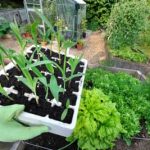It is a time for rest and indulgence for many, but one that often leads to unnecessary waste. The Soil Association, the UK’s biggest organic lobbying group, estimates that 5m puddings, 2m turkeys and 74m mince pies are binned every year.
So how can we have a more sustainable holiday? By being aware of what we are buying, says Conor Spacey, the author of Wasted, a cookbook based on using all parts of any given ingredient.
“Christmas is traditionally a feast holiday, but having a more sustainable one doesn’t mean we have to eat less – it’s more about being conscious of what we eat,” he says.
Buying and budgeting
Planning ahead means that you will avoid unnecessary spending and waste from the Christmas dinner, as well as any other food you may be tempted to buy, thanks to the lure of supermarket end-of-aisle offers.
So make a list and stick to it. This means understanding how much food people are likely to eat.
For a turkey dinner, of course this can vary according to appetite but according to Dominique Woolf, a chef and author, as a guide you will need about 400g of turkey per person if buying a crown, and 500g if it’s a whole bird.
Jassy Davis of online grocer Abel & Cole says: “You probably need a smaller turkey than you think. Between 150g and 200g of cooked turkey is normally enough for most people. That means a leg will serve two; a 2.5kg crown, four to six; and a small 4.5kg turkey, eight.”
Buying meat on the bone means you will be able to use it for stock afterwards, says David Lagonell, chef director at the Temper chain of restaurants. Local butchers should be the first port of call, he says. “Unfortunately, supermarkets don’t always have sustainability at the forefront of what they sell, especially at this time of year when the sheer volume doesn’t allow it.
“But the power of decision remains with us. I’d much rather buy really good poultry, than mediocre beef for the same price.”
Vegetables typically used for Christmas dinner – carrots, parsnips, onions, celery and sprouts – are all in season and should be bought to support growers, says Spacey.
“Buying loose vegetables ensures that you cut down on plastic and that you only buy what you need. More waste can often be caused by buying vegetables that are already packed in plastic, and contain more than you want, meaning that you have to find other ways to use them.”
Davis says about 250g of potatoes per person is enough, and 80g each of other vegetables, such as sprouts, carrots, cabbage and parsnips.
Choose the right storage
Storing food before and after it is cooked dictates how long it lasts and prevents waste. Spacey says root vegetables and tomatoes are best stored outside the fridge at room temperature, as are exotic fruits such as melons, pineapples and bananas.
Most items from the dinner can be frozen afterwards, including turkey, cranberry sauce and cooked vegetables, as well as cake and chocolates (if there are any left), says Woolf.
Some cheeses can also be put in the freezer, such as hard and semi-hard ones, although soft ones don’t fare well. Emma Young, author of The Cheese Wheel, says using wax or greaseproof paper is the best way to wrap cheeses in the fridge. If using plastic containers, store similar cheeses together. If you put a Stilton with a cheddar, the moulds will jump from one to the other. If you do see mould, simply trim it away.
Using up leftovers
The Boxing Day turkey curry is almost as much part of Christmas as the turkey itself, but it does not have to be. Groups and chefs pushing sustainability have numerous suggestions on what to do with leftovers.
The Soil Association has a series of zero-waste recipes, including brussels sprout sauerkraut, turkey and cranberry pie and sweetcorn and turkey chowder.
Spacey says the offcuts from vegetables can be deep fried and made into crisps. He adds: “Outer brussels sprout leaves make a wonderful, earthy, pesto. Simply place them into boiling water for 30 seconds, then refresh under cold water. Squeeze dry and add equal quantities of the leaves with basil to a blender.
“Add toasted nuts and Parmesan, and blend, slowly adding rapeseed oil and salt and pepper until it becomes a paste.”
Davis says it is important to plan the meals around Christmas Day, such as what you will eat on 27 December, so that the extra is used up rather than “hoping you’ll find a time to use them up”.
Wine … a weighty issue
The glass bottles in which wine is stored have been pinpointed as the main reason behind the industry’s carbon footprint – from how they are made to the transport demands of shipping them around the world.
The Sustainable Wine Roundtable, a collaboration by groups in the wine trade, has recommended that retail members should reduce the average weight of bottles from 550g to 420g by the end of 2026.
Naked Wines, which signed the “bottle weight accord”, says: “For years there has been a myth that a heavy glass wine bottle means it must be high quality. This simply isn’t true.
“Many of the most highly regarded wines in the world don’t have them. But because the myth continues, brands continue to use them to appeal to consumers who may not be aware that it’s a myth, or of the resulting impact on the environment. Heavy bottles are often seen at times of celebration.”
For consumers who want to buy lighter, the only existing test at the moment is simply to pick up a bottle and compare it with another one. Heavier glass may have some embossing on it, and occasionally, more progressive makers put the weight on the packaging.



